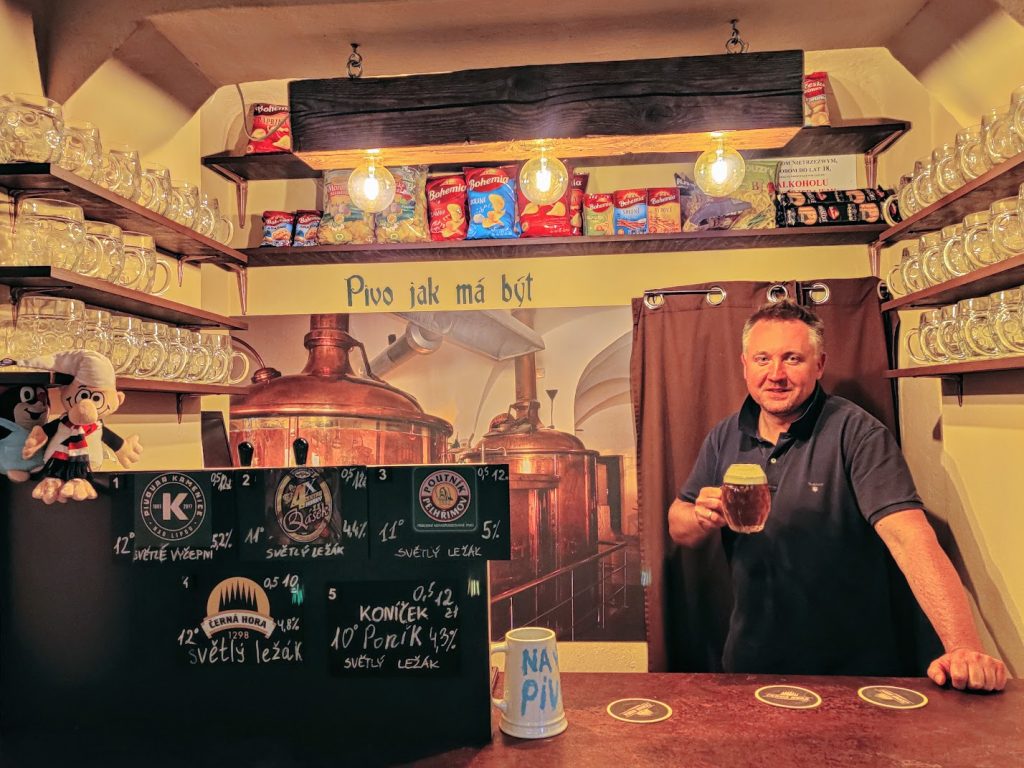
Warsaw – The (Beating) Heart of the City
Distance to walk: 2 kilometres
Estimated walking time:
Brisk walk: 30 minutes
Beer in hand: 2 hours
Starting point: Gorączka Złota (Gold Rush), Wilcza 29
Route stops:
- GORĄCZKA ZŁOTA (GOLD RUSH), Wilcza 29 Street
- KAMIENICA IZAAKA ROTHBERGA (IZAAK ROTHBERG’S TENEMENT HOUSE), 66 Marszałkowska Street 66
- MINISTERSTWO ROLNICTWA (MINISTRY OF AGRICULTURE), 30 Wspólna Street
- PARKING PIĘTROWY (MULTI-STOREY CAR PARK), 27 Nowogrodzka Street
- ULICA NOWOGRODZKA (NOWOGRODZKA STREET)
- KAMIENICA NOWOGRODZKA 25 (25 NOWOGRODZKA ST. TENEMENT HOUSE)
- KUFLE I KAPSLE (MUGS & CAPS), 25 Nowogrodzka Street
- KAMIENICA DOROTY PRYBE (DOROTA PRYBE’S TENEMENT HOUSE), 14 Nowogrodzka Street
- KAMIENICA POLAMINÓW (POLAMIN FAMILY TENEMENT HOUSE), 12 Nowogrodzka Street
- JABEERWOCKY, 12 Nowogrodzka Street
- ULICA KRUCZA (KRUCZA STREET)
- KAMIENICA WILCZYŃSKICH (WILCZYŃSKI FAMILY TENEMENT HOUSE), 4 Nowogrodzka Street
- DRUGIE DNO (SECOND BOTTOM), 4 Nowogrodzka Street
- ULICA MYSIA I CENZURA (MYSIA STREET & CENSORSHIP)
- DOM PARTII (POLISH UNITED WORKERS’ PARTY HQ), 6/12 Nowy Świat Street
- CUDA NA KIJU (WONDERS ON A STICK), 6/12 Nowy Świat Street
- MOSAIC, southern side of the viaduct at the intersection of Grydzewski and Czapski avenues
- WARSZAWA-POWIŚLE RAILWAY STATION
- PONIATOWSKI BRIDGE
- CZESKA BASZTA (BOHEMIAN TURRET), Tower base in Solec Street, 81B/B22 Poniatowski Bridge
The (Beating) Heart of the City
The trail below we called “The (Beating) Heart of the City”. Its importance to us comes from the fact that it connects the major establishments that were created at the very beginning of the craft beer revolution (or even before it had started). We lost and found our way on this very route on many days and nights (and even some mornings). We met fantastic people in these streets and watched them change as we strolled along them in high spirit. The history of Gorączka Złota (Gold Rush), Nowogrodzka Street, Cuda na Kiju (Wonders on a Stick) or Czeska Baszta (Czech Tower) is both our past and present. Simply walking down these streets makes us remember old friendships, high school sweethearts, as well as the taste of the first pint of craft beers that made us fall in love with it for eternity. As if it had happened only yesterday. Like a first kiss. This route is absolutely special to us. Sweet, intimate, full of warmth.
The trail itself is merely a suggestion. You can follow it any way you like, randomly visiting individual stops, either alone or in good company. But if you choose this trail, make sure you get to the Czech Tower, last stop on this route, before closing hours.
The authors
All fun facts that are not about beer are by Piotr “Pietia” Wierzbicki who loves our city no less than we do craft beer. He is a varsavianist, an expert on all things Warsaw, and author of the book “Hoppy History of Warsaw”. You can find his fascinating articles in the monthly “Skarpa Warszawska”. He’s in charge of the “Warszawa na wyrywki” Facebook page (‘Warsaw at random’) – like this profile and you will never again miss any trips full of curiosities, lectures and meetings.
Translation was made by Mirek Kołodziej – fan of Arabian horses passionate about craft beer, always on the lookout for delicious food while travelling, eager to pop into any museum on his way.
The authors of the remaining entries are:
Przemek Iwanek (judge and organiser of beer competitions, Alchemia podcast, Cydr Pełnia, co-organiser of the Warsaw Beer Festival)
Marcin Orwicz (Mgła Chmielu – Fog of Hops, or collected beer events in Warsaw)
Michał Sułkowski (beer judge, Kilka Słów o Piwie – A Few Words about Beer, Piwna Mapa Warszawy – Warsaw Beer Map)
Edited by: Paweł Leszczyński (beer judge, organiser of the Warsaw Beer Festival and the guy behind several other craft beer initiatives).
If you find any mistakes at all or would like to share some constructive criticism concerning our project, be sure to let us know!
BACK TO THE MAP / BACK TO THE LIST
1. GORĄCZKA ZŁOTA (GOLD RUSH)
29 Wilcza Street
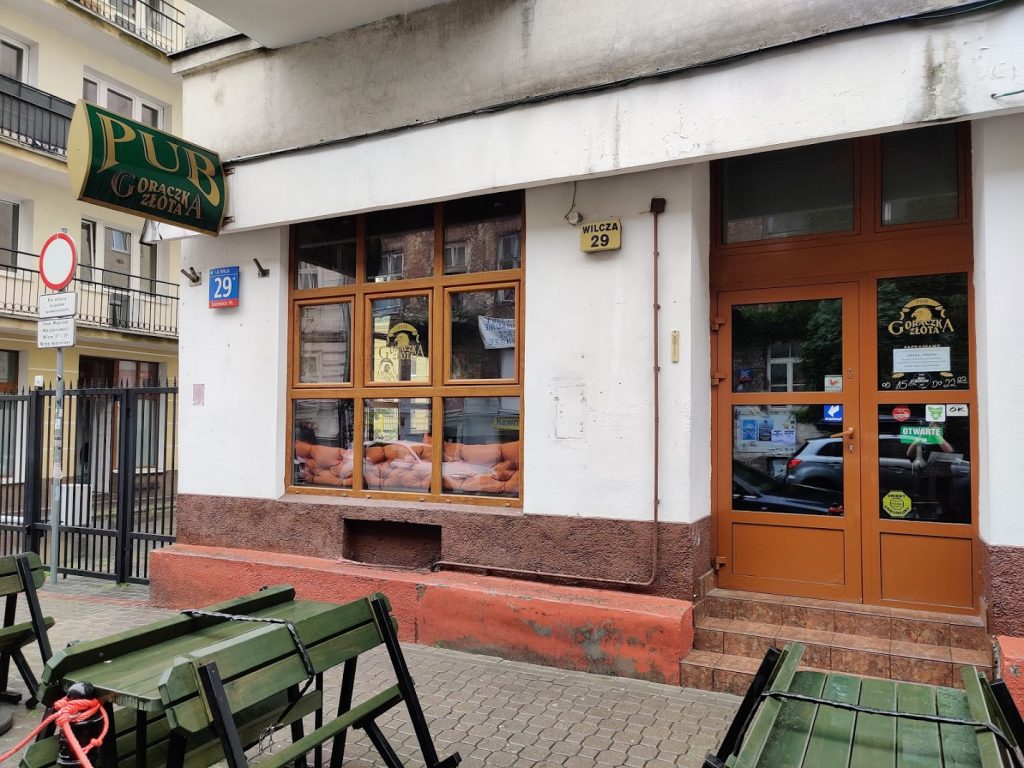
Gorączka Złota (Gold Rush)
The pub’s Facebook page
Number of taps: 5
Current menu: ontap.pl
Cuisine: traditional Polish
Opening hours:
Monday-Wednesday: 3 pm–10 pm
Thursday: 3 pm–10:15 pm
Friday: 3 pm–10:45 pm
Saturday: 5 pm–11:15 pm
Sunday: closed
In business since 1996, a downtown pub famous throughout the capital for its great beer and delicious food. A small, atmospheric joint (in the summer, there is also a beer garden in front of the premises), walls decorated with coasters (that we call “waffles” in Polish) and license plates – both from all around the world. Five taps, mainly Polish craft, but also Czech and German classics. The owner – Mrs. Małgosia, without whom it is difficult to imagine this place, will always be happy to tell one of the thousand stories that took place in this cosy place. The cuisine deserves special praise, as the kitchen team prepares dishes from Warsaw and the region very often using seasonal products. In this place, love is one of the ingredients! This is the perfect place for a tête-à-tête, so we recommend making a reservation!
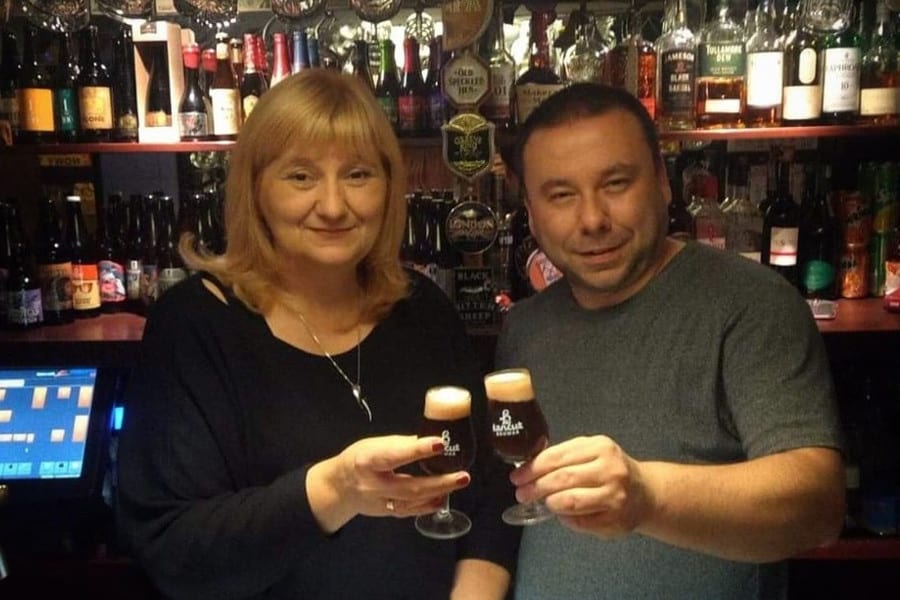

HOW TO GET TO THE NEXT STOP
Take Wilcza Street towards Marszałkowska Street, and there turn right. The next point is on the corner of these streets. A few steps away from Gorączka Złota, you can find the unique shop of “Kooperatywa Dobrze” (“Good Food Co-op”), another place dear to our hearts where you can buy high-quality groceries.
BACK TO THE MAP / BACK TO THE LIST
2. KAMIENICA IZAAKA ROTHBERGA (IZAAK ROTHBERG’S TENEMENT HOUSE)
66 Marszałkowska Street
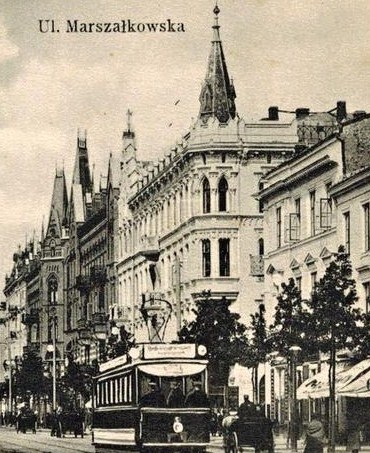
The only surviving element at the intersection of Marszałkowska and Wilcza from the olden times. This house, built in 1894, was designed by Stefan Szyller, but little is left of the Gothic Revival interior of this once magnificent tenement house. Damaged during the war, the details of the façade were chiselled away, and it was plastered grey. On the corner, in times of the People’s Republic of Poland, there was a pub called “Żywiec”, do not confuse it with the restaurant bearing the same name, which operated in the north-eastern corner of Marszałkowska and Jerozolimskie streets before the war.

HOW TO GET TO THE NEXT STOP
Take Marszałkowska towards the Palace of Culture and Science and turn right into Wspólna Street. Our next stop, the Ministry of Agriculture, is at the junction of Wspólna and Parkingowa. It’s really worth having a look at the Ministry’s building from this side to see its magnificent colonnade (scroll down to find out more). Then, stroll down Parkingowa – watch out though, as it can get crowded on a weekend.
BACK TO THE MAP / BACK TO THE LIST
3. MINISTERSTWO ROLNICTWA (MINISTRY OF AGRICULTURE)
30 Wspólna Street
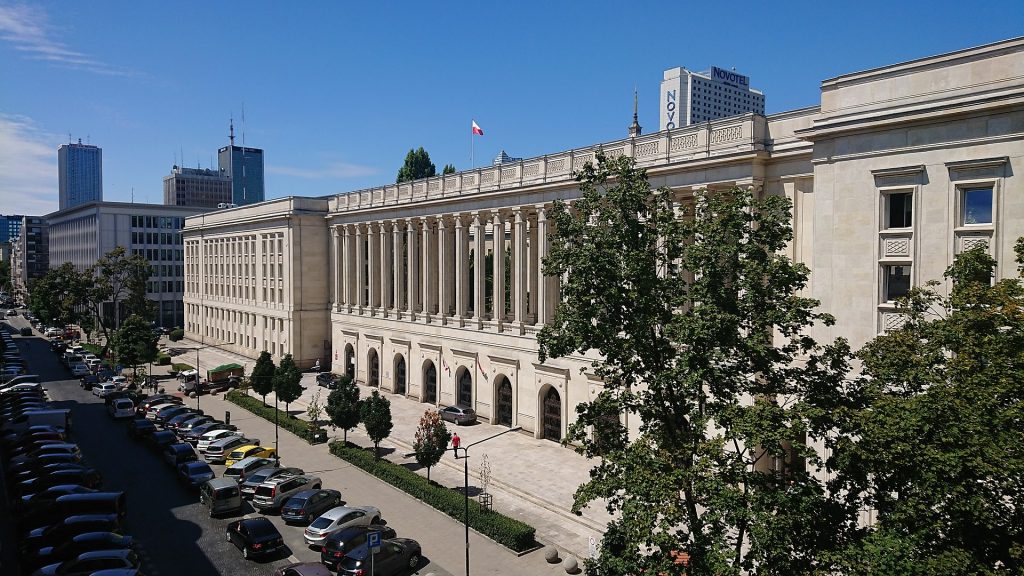
Built in 1950-55, this is one of the largest “soc-palaces” in Warsaw whose façade is unmatched in terms of monumentality. Its two wings are connected by a 70-metre-long colonnade set on a pedestal with arcades connecting the street with the garden inside. The colonnade is topped with an intricate baluster attic. The composition is an enlarged and geometrised homage to the Saski Palace colonnade. On the façade, you may find the “business card” left by its architects: Jan Knothe, Jan Grabowski and Stanisław Jankowski.
“Soc-palace” is short for ‘socialist palace’ or ‘social realist palace’. To pronounce it right, say the ‘soc’ part as if were written ‘sotz’. Now you’re ready to go to…

HOW TO GET TO THE NEXT STOP
We follow Parkingowa Street towards ul. Nowogrodzka. The name of the street – you guessed it right – means ‘parking street’. The parking lot with pubs on the ground floor will be on your right.
BACK TO THE MAP / BACK TO THE LIST
4. PARKING PIĘTROWY (MULTI-STOREY CAR PARK)
27 Nowogrodzka Street
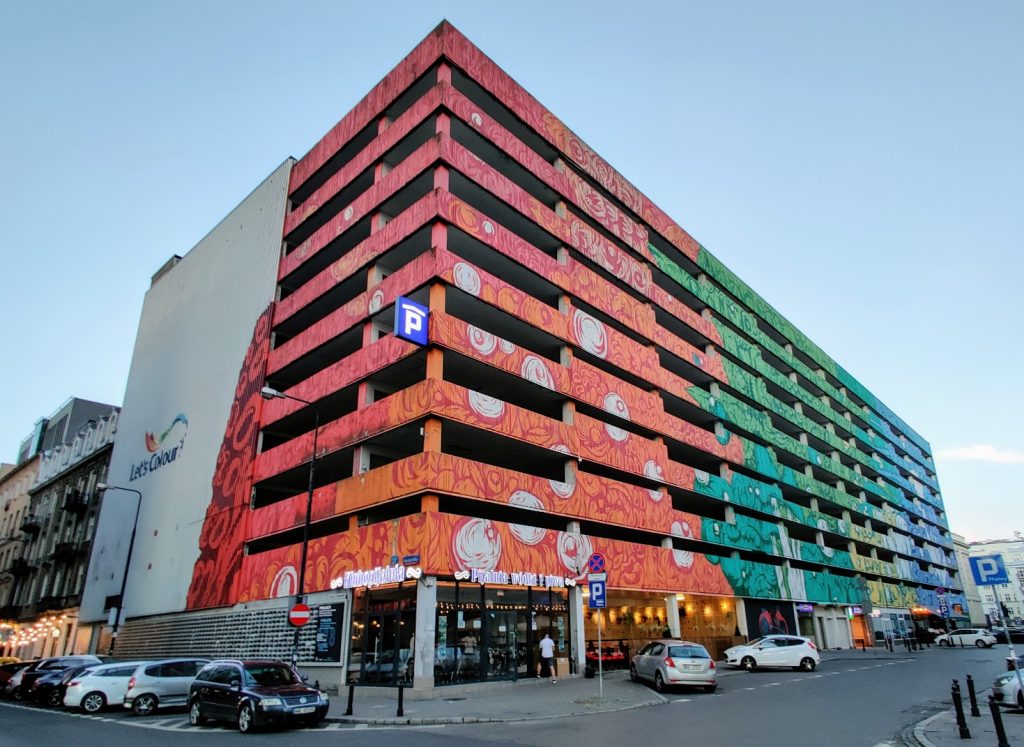
One of the largest facilities of this type in Warsaw that can accommodate up to 700 cars. It was built by the Swedes in 1973 together with the next-door “Forum” hotel (now “Novotel Centrum”). This is where the chase scene takes place in the series “07 zgłoś się”, known internationally as “07 Come In” (look for episode “300 tys. w nowych banknotach”, that is “300,000 in new banknotes”), when Lieutenant Borewicz chases a criminal who has stolen a police car. It is decorated with one of the largest murals in Poland. The composition of colours and elements by Swanski symbolises the interpenetration of everything in nature. The campaign was financed by the paint producer “Dulux”. These are probably the last months of this building’s operations, as at the beginning of April 2020, a motion to demolish it was submitted to the city council.
BACK TO THE MAP / BACK TO THE LIST
5. ULICA NOWOGRODZKA (NOWOGRODZKA STREET)
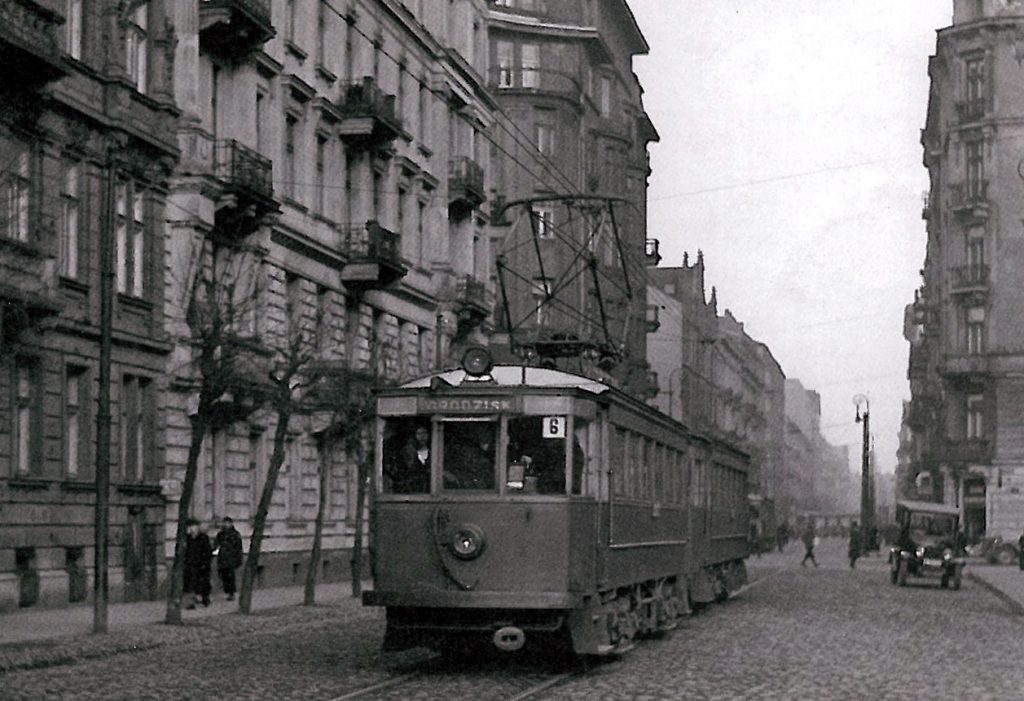
One of the oldest roads in Warsaw. From 1678, it belonged to the order of missionary priests of the Holy Cross, together with the Nowy Gród (later Nowogrodzka) Jurisdiction founded 100 years later. The missionaries established a farm on the southern side of the road with many buildings between today’s Emilii Plater and Poznańska Streets. The street was given its name in 1770. Urban buildings began to appear in the second half of the 19th century. In the years 1927-63, the Electric Commuter Railway ran along Nowogrodzka Street with the final stop at tenement house no. 36.
BACK TO THE MAP / BACK TO THE LIST
6. KAMIENICA NOWOGRODZKA 25 (25 NOWOGRODZKA ST. TENEMENT HOUSE)
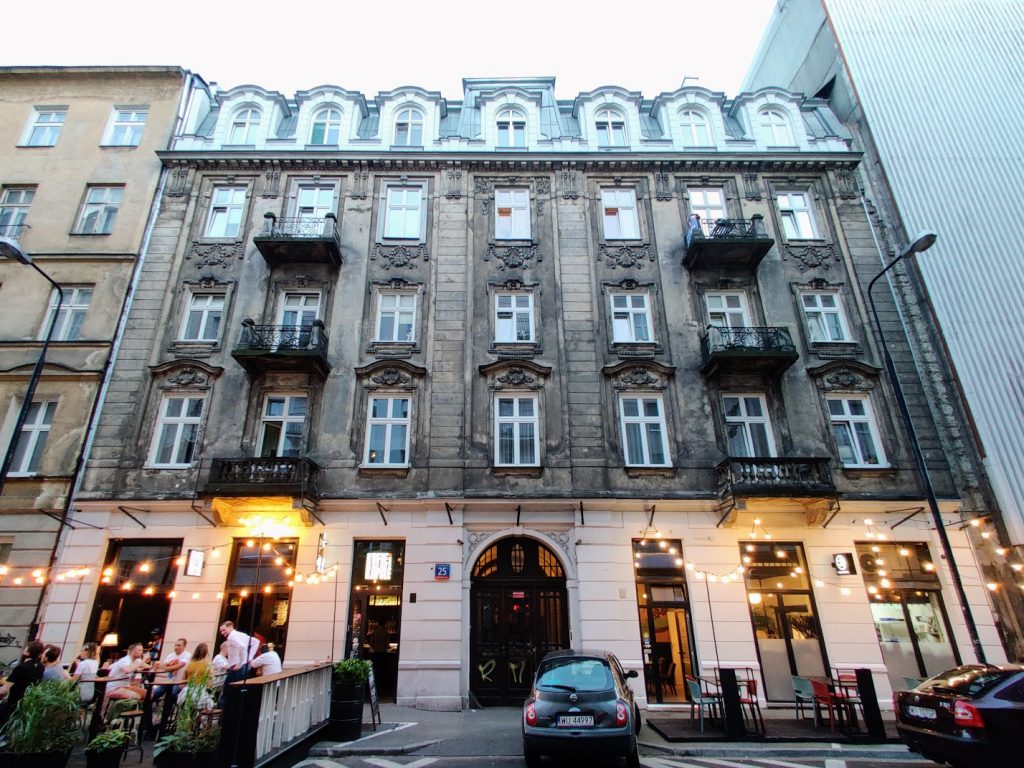
It was built as a two-storey house with a mansard roof and a completely different interior in the years 1862-63 according to the design of the co-owner Rafał Krajewski. He was a member of the national government (director of the department of internal affairs) during the January Uprising, and was executed at the Warsaw Citadel – together with Romuald Traugutt, the leader of the Uprising – on 5th August 1864. A relic of the old, completely unknown decor is the motif of a wreath interwoven with a ribbon. Rebuilt in 1900 on the initiative of the then owner Józef Narbutowicz. It is then that two new storeys and an eclectic decoration preserved until today were added.
BACK TO THE MAP / BACK TO THE LIST
7. KUFLE I KAPSLE (MUGS & CAPS)
25 Nowogrodzka Street
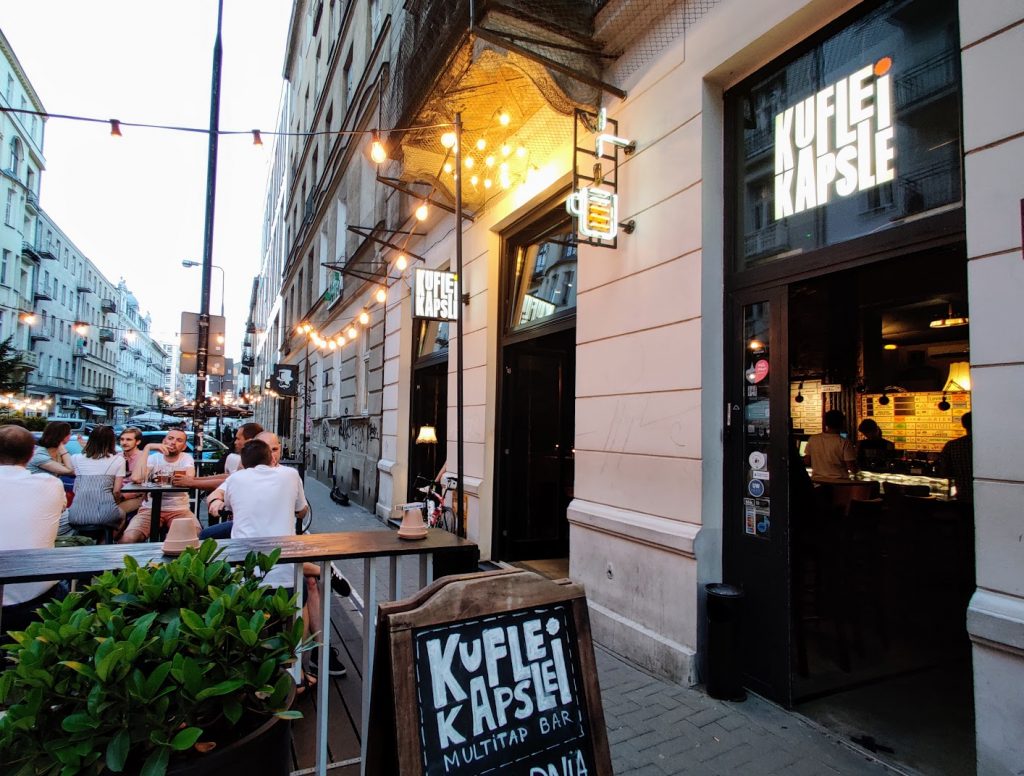
Kufle i Kapsle (Mugs & Caps)
The pub’s Facebook page
Number of taps: 20
Current menu: ontap.pl
Cuisine: snacks
Opening hours:
Monday-Thursday: 2 pm–2 am
Friday: 2 pm–4 am
Saturday: noon–4 am
Sunday: noon–2 am
This is one of the places that is recommended most often, opened in 2013 on the rather ugly and avoided back in the day by tourists Nowogrodzka Street. Nowadays, a street that never sleeps always encouraging to enjoy life a little more, referred to as the beer street or the beer hub. Kufle i Kapsle, often referred to simply as KiK, has become famous within the beer community for highly creative events – beer meetings and premieres. It’s hard to squeeze in at peak times, but definitely worth it. A selection of 20 taps and an even wider selection of bottles await you here. At the tables or at the bar, you can meet writers, musicians, and city activists. The team consistently maintain a high level, both in terms of the selection of beer on tap and the tasting conditions. The specific décor reminiscent of Krakow’s cellars was often copied by other establishments (copycats).

HOW TO GET TO THE NEXT STOP
Having turned right on the corner, continue down Nowogrodzka Street.
BACK TO THE MAP / BACK TO THE LIST
8. KAMIENICA DOROTY PRYBE (DOROTA PRYBE’S TENEMENT HOUSE)
14 Nowogrodzka Street
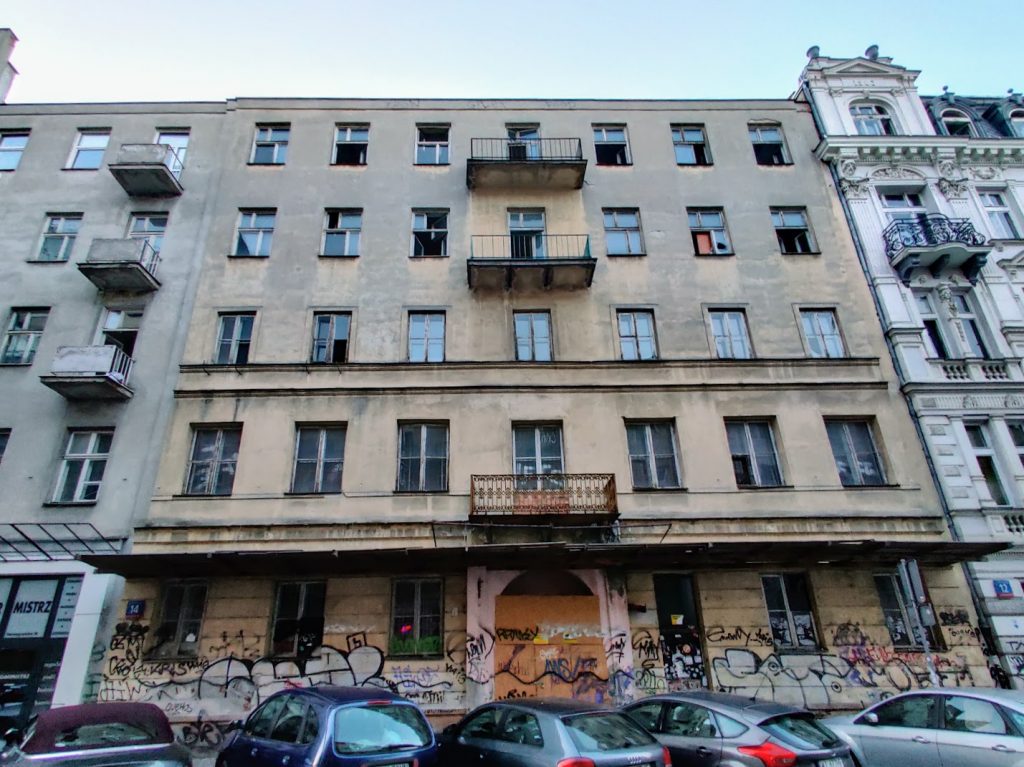
Built in 1863, the house became the crime scene where a turbulent love affair met its tragic end. In 1890, in a small apartment to the left of the gate on the ground floor, the tsarist officer Alexander Bartenyev fatally shot Maria Wisnowska. Famous in the 1880s, the actress was a femme fatale and celebrity. Bartenyev was sentenced to 8 years of hard labour, but was eventually pardoned by the tsar himself. Allegedly, after the revolution, Bartenyev returned to Warsaw and lived a homeless life, spending most days at Maria’s grave in Powązki cemetery. Find out more…

HOW TO GET TO THE NEXT STOP
Continue down Nowogrodzka Street.
BACK TO THE MAP / BACK TO THE LIST
9. KAMIENICA POLAMINÓW (POLAMIN FAMILY TENEMENT HOUSE)
12 Nowogrodzka 12 Street
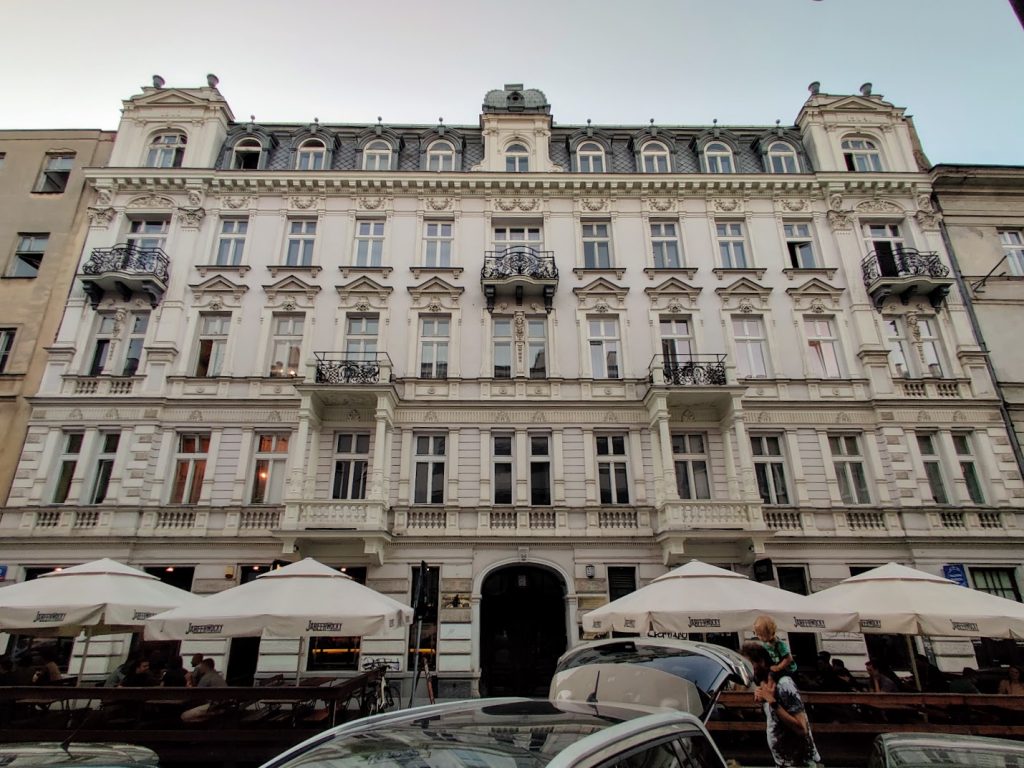
Built in 1904 according to the design of Maurycy Kastens, the tenement house has a well-preserved neo-baroque façade, renovated in the 90s. It is one of the most impressive downtown façades dating to the beginning of the 20th century with beautiful Art Nouveau plant motifs and sculptures of female and male heads. In 1925, the new owner of the house put into use 17 bachelor rooms in the mansard roof attic.
BACK TO THE MAP / BACK TO THE LIST
10. JABEERWOCKY
12 Nowogrodzka 12 Street
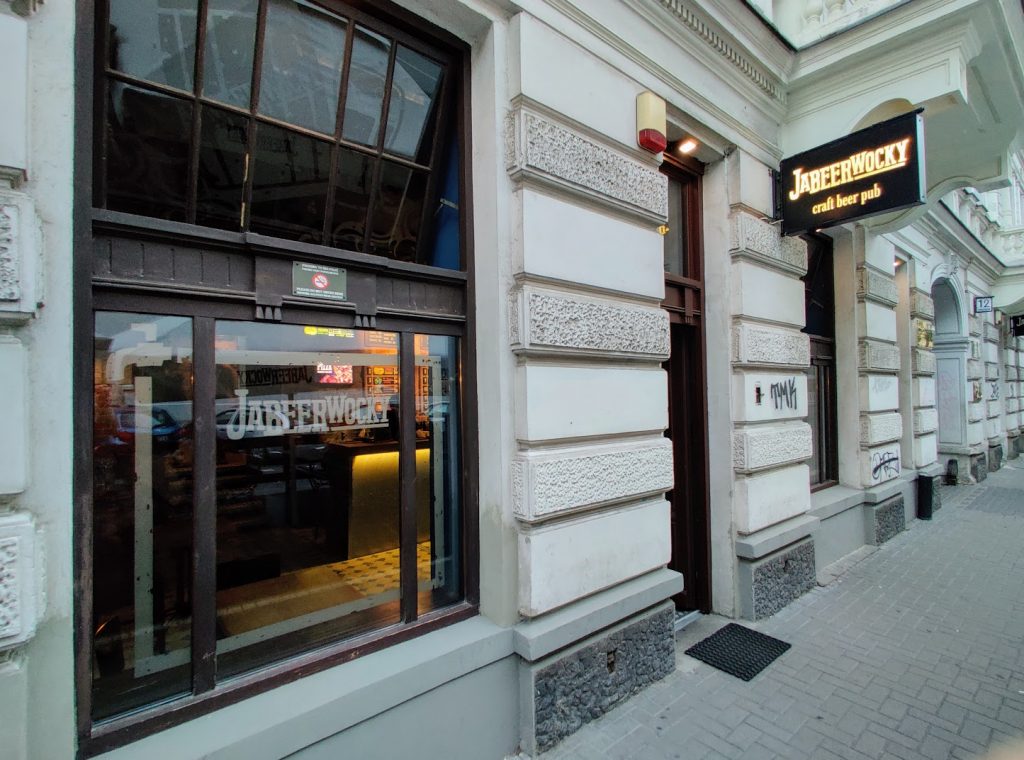
Jabeerwocky
The pub’s Facebook page
Number of taps: 17
Current menu: ontap.pl
Cuisine: pizza
Opening hours:
Monday-Thursday: 2 pm–midnight
Friday-Saturday: 2 pm–2 am
Sunday: 3 pm–midnight
A place with a rock soul, 17 taps and even more beer collaborations with multiple breweries. They also operate as a craft brewery and educate on craft beer on their very own YouTube channel. Some people love Jabeerwocky, others hate them, but nobody passes by them indifferently. Red brick and drawings on the beer board are a characteristic element of the interior design of this place, founded and established in 2015 by one of the most experienced beer judges in Poland – Rafał Kowalczyk. There is a TV, so you watch a game and enjoy a beer at the same time. Should you visit this pub, look for errors on the style map on the wall. Anyway, Jabeerwocky was chosen the best place on the Beer Map of Warsaw twice already: in 2016 and 2018, because the climate and beer selection there are unparalleled. An interesting fact: next to the entrance to the toilet, there is a prototype of a craft brewery equipment designed by the owner himself. P.S. This is the only existing copy.
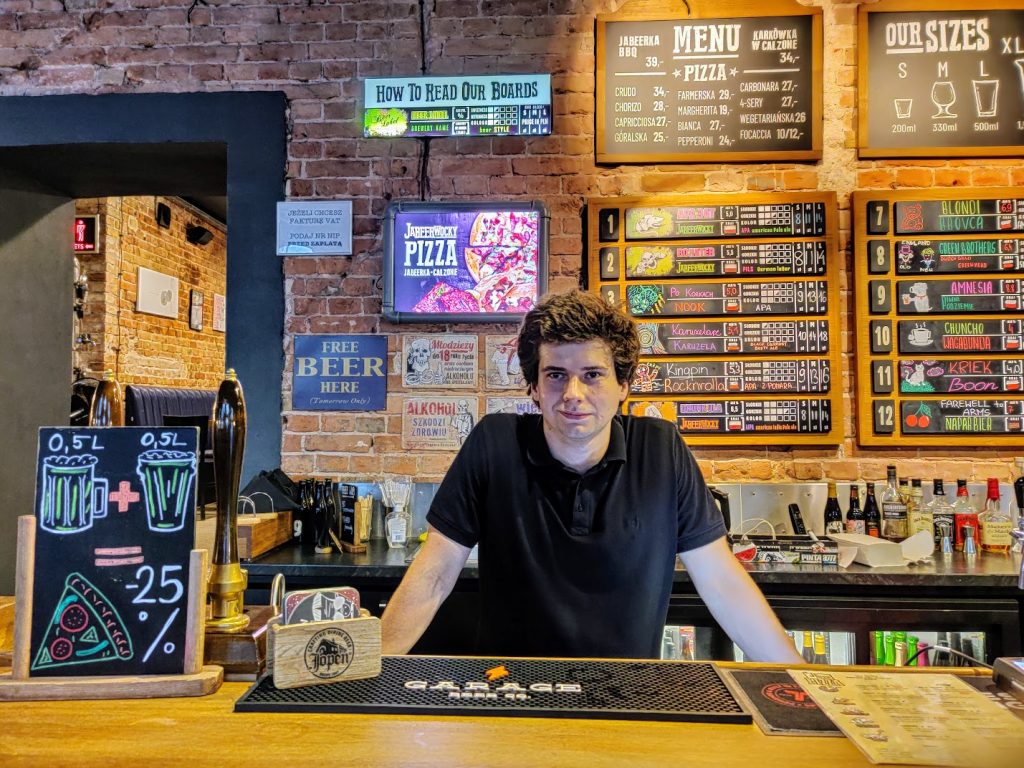

HOW TO GET TO THE NEXT STOP
Continue down Nowogrodzka Street.
BACK TO THE MAP / BACK TO THE LIST
11. ULICA KRUCZA (KRUCZA STREET)
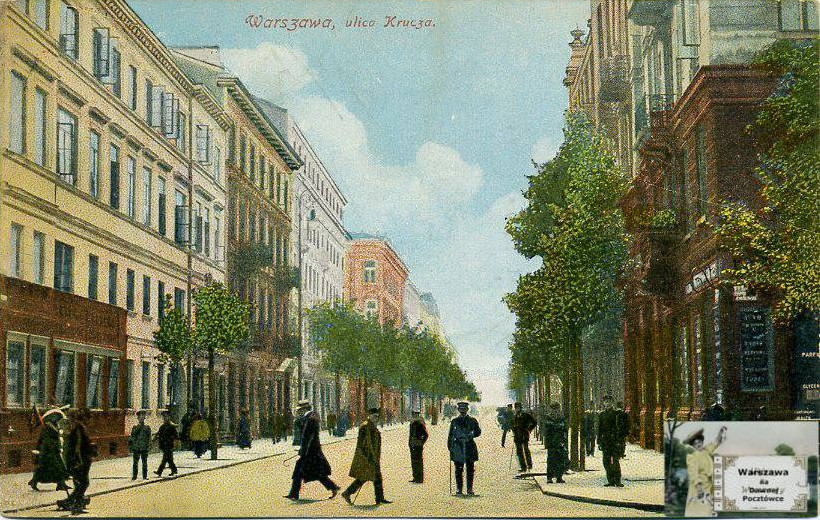
Contrary to public belief, the name of the street does not come from “kruk” the bird (raven), but from black mud that back in the old days used to be called “kruk”. In the second half of the 18th century, the road, which later became a street, ran from the intersection of Mokotowska and Piękna Streets south from here up to Nowogrodzka Street. If you wandered further north, there was – you guessed it – mud. From the 1870s, along Krucza numerous tenement houses were built, two of which have survived to our times (no. 3 and 13). After the war, it became part of the so-called “ministerial axis”, the government and office district. It was therefore radically enlarged by shifting the eastern frontage, on which 6 office buildings and the “Grand” hotel were built.

HOW TO GET TO THE NEXT STOP
Continue down Nowogrodzka Street.
BACK TO THE MAP / BACK TO THE LIST
12. KAMIENICA WILCZYŃSKICH (WILCZYŃSKI FAMILY TENEMENT HOUSE)
4 Nowogrodzka 4 Street
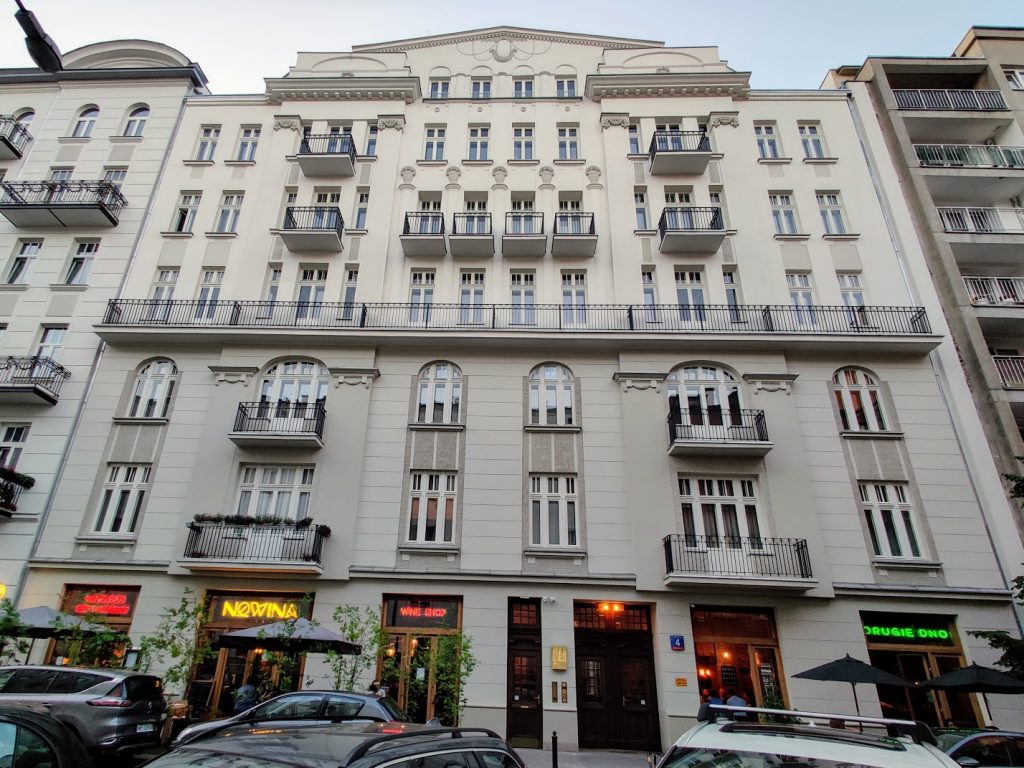
Built in 1914 by a construction entrepreneur Rudolf Wilczyński, the five-storey building has a striking façade designed in the spirit of heavily modernised empire and early French classicism. On each floor, there were 2 apartments with an area of over 130 square meters each. The ceilings of the apartments were decorated with stucco garlands in the shape of roses. There was a crystal glass elevator in the parade staircase. Tiny lifts were also mounted on the kitchen staircases: they were used by servants to bring in their shopping. Find out more…
BACK TO THE MAP / BACK TO THE LIST
13. DRUGIE DNO (SECOND BOTTOM)
4 Nowogrodzka Street
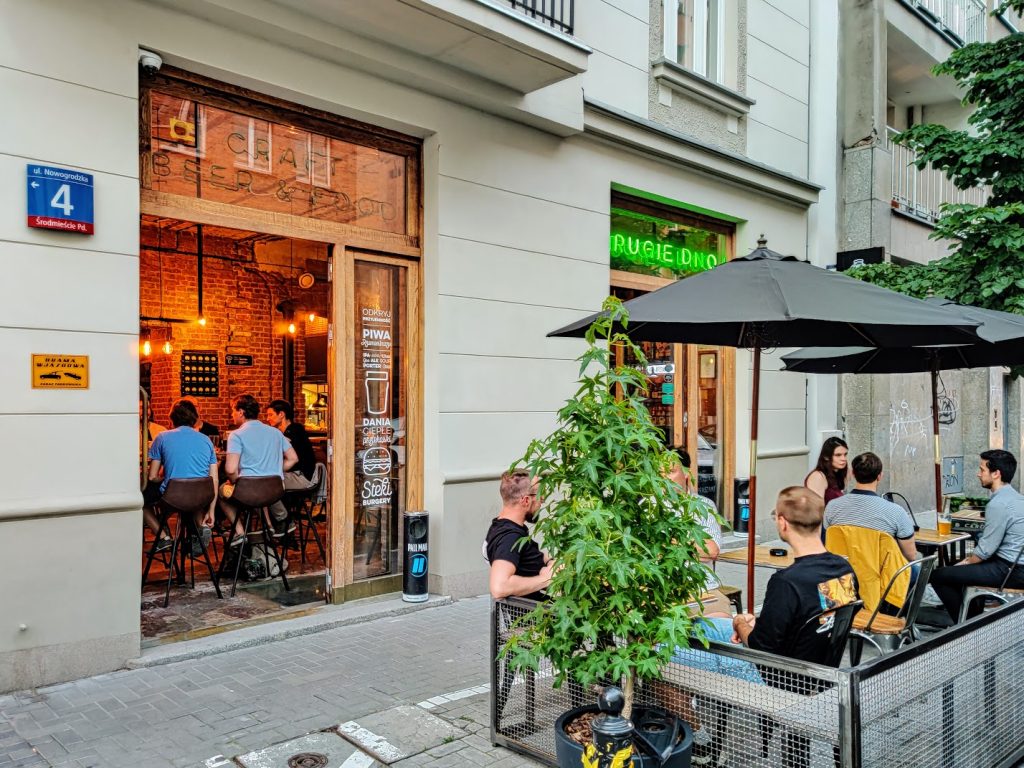
Drugie Dno (Second Bottom)
The pub’s Facebook page
Number of taps: 16
Current menu: ontap.pl
Cuisine: burgers, pizza, steaks
Opening hours:
Monday-Thursday: 2 pm–2 am
Friday: 2 pm–4 am
Saturday: noon–4 am
Sunday: noon–2 am
Nowogrodzka is undoubtedly the street in Warsaw with the most craft beer. This is also where another multitap on our trail is located: Drugie Dno whose name translated into English is Second Bottom. Craft beer and ciders are poured here from 16 taps, and there is also a proper kitchen to the left of the bar. Why you ask? That’s because here you can eat not only snacks or fast-food burger/hotdog classics. Really hungry people will find something for themselves too, such as delicious seasoned steaks. No worries: meatless options are also on the menu. The interior design is modern, industrial, and metropolitan, while the service, cuisine, and selection of beers – top notch. The Second Bottom proves that multitaps do not have to be caves only for accomplished beer geeks – this right here is definitely a more democratic place. You can just as well pop in for a beer with friends or take a business partner of yours to talk shop, you will meet veterans of craft and a foreign tourist looking for a pint. Anyway, even though the place is spacious (two storeys, mezzanine and a mini garden in the summer), it can get crowded on weekends.
P.S. Fun fact: in Polish, to say that something has a “second bottom” means that it has a hidden meaning.


HOW TO GET TO THE NEXT STOP
Continue down Nowogrodzka Street which seamlessly transforms into Mysia Street.
BACK TO THE MAP / BACK TO THE LIST
14. ULICA MYSIA I CENZURA (MYSIA STREET & CENSORSHIP)
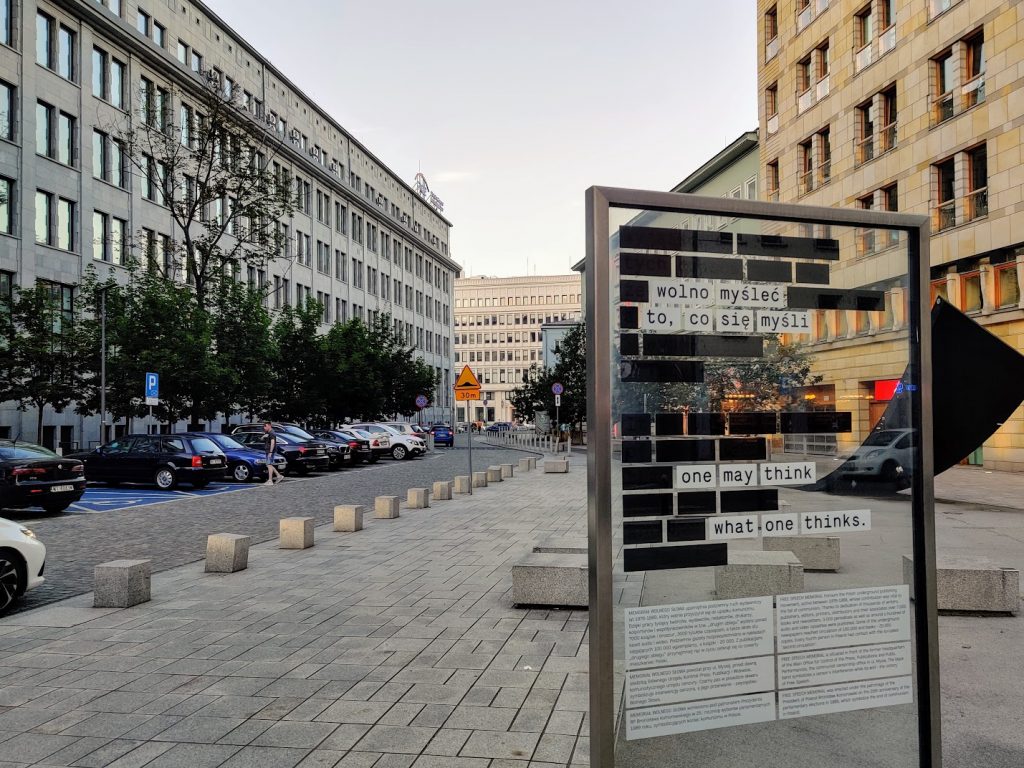
In the old days, a tiny street linking Bracka Street and Nowy Świat (135 metres long and 6 metres wide) was probably the reason for the name Mysia – Mouse Street. It disappeared completely in mid-19th century, becoming the backyard of tenement houses located in Nowy Świat. It was reborn during the post-war reconstruction, but unfortunately it became dreaded by some and infamous, as the Polish authorities located in Mysia 3 the Central Office of Publications, Press and Performances Control, or simply Censorship. Only the eastern wing of this building has survived to our times. Most of the building was demolished to free up space to construct the “Liberty Corner” office building.

HOW TO GET TO THE NEXT STOP
Continue down Mysia Street and you will end up on Nowy Świat – the street is called the New World. In front of you, there’s the Polish United Workers’ Party HQ (nowadays often called the Stock Exchange, even though it was moved to 4 Książęca Street), and to the right Plac Trzech Krzyży – Three Crosses Square. Let’s turn left and approach the Party HQ from Jerozolimskie Avenue. There’s a pub there called Cuda na Kiju – Wonders on a Stick.
BACK TO THE MAP / BACK TO THE LIST
15. DOM PARTII (POLISH UNITED WORKERS’ PARTY HQ)
6/12 Nowy Świat Street
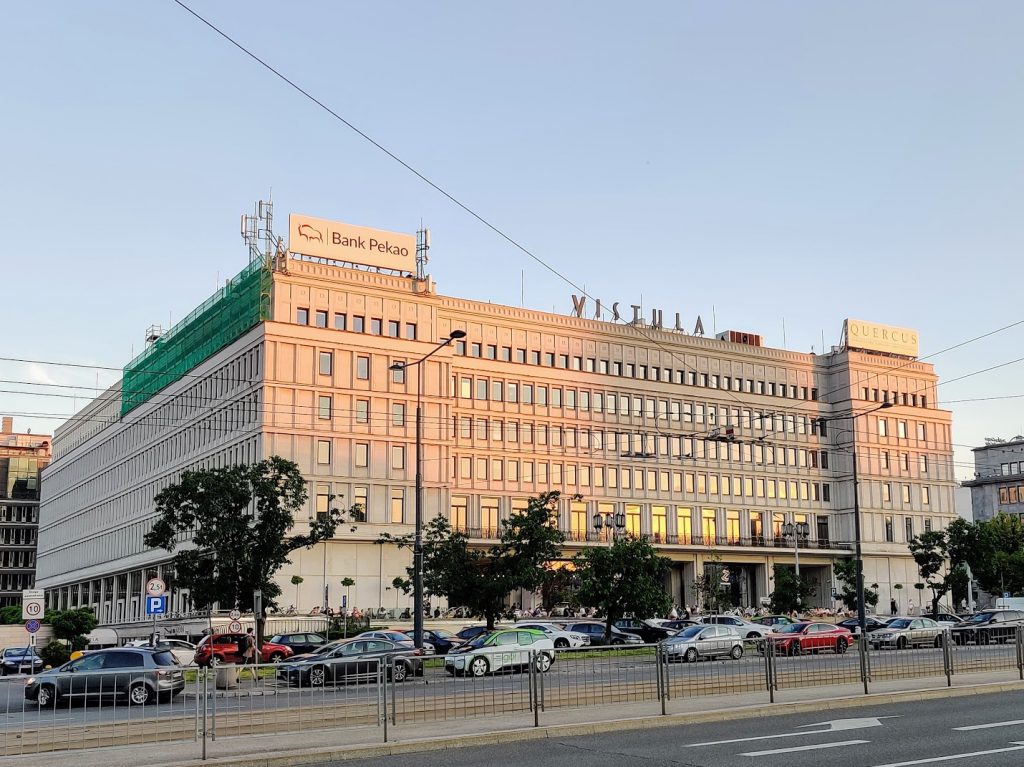
The seat of the Polish United Workers’ Party was built in 1948-52 according to the design of the so-called “Tigers” (a famous group of architects: Eugeniusz Wierzbicki, Jerzy Mokszyński and Wacław Kłyszewski). Mistakenly considered to be built in the style socialist realism, it is in fact a monumental example of modernism in full swing. According to the original concept, the demonstrations of the joyous people were to pass through the courtyard of the building, greeted by the leaders from the balconies. This idea was abandoned due to the fact that two large tenement houses at the corner of Nowy Świat and Książęca streets were left standing in the way of potential processions. In the period of the Polish People’s Republic, the courtyard was not accessible, the passages were guarded by Government Protection Bureau officers dressed as traffic police.
BACK TO THE MAP / BACK TO THE LIST
16. CUDA NA KIJU (WONDERS ON A STICK)
6/12 Nowy Świat Street (Party HQ)
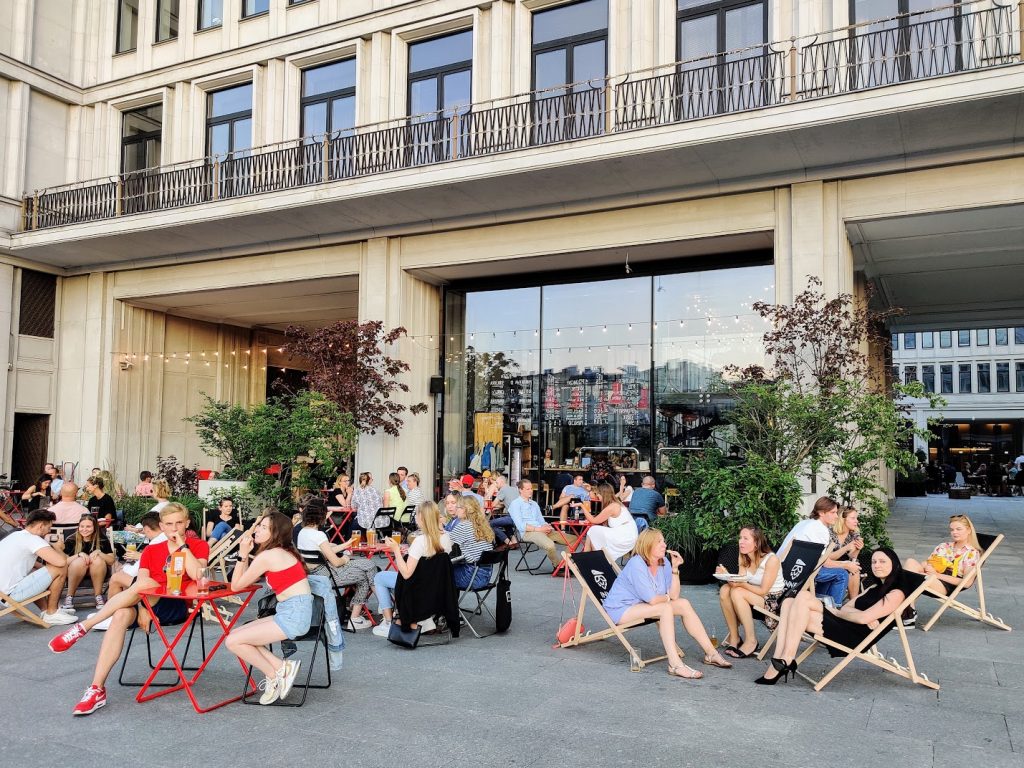
Cuda na Kiju (Wonders on a Stick)
The pub’s Facebook page
Number of taps: 20
Current menu: ontap.pl
Cuisine: pizza
Opening hours:
Monday-Thursday: noon–1 am
Friday-Saturday: noon–2 am
Sunday: noon–midnight
The place with the best view out of all the capital city’s multitaps, located in the Party HQ, the former seat of the Central Committee of the Polish United Workers’ Party – the relic of times rightly gone by is experiencing its second youth. When you order a beer, you can see the General Charles de Gaulle Roundabout, an evergreen palm tree and Trakt Królewski – the King’s Road leading to the Old Town which is vibrant around the clock. This is where one of the clearest beer menus in the world can be found, because the selection on the taps is written on the glass through which you can see the aforementioned panorama. Here you will also find probably the largest beer garden in Warsaw, located in the courtyard of the building. It is worth ordering a pizza with your beer – you will not be disappointed. However, the place itself is not a typical place for beer geeks, it combines urban lifestyle with relaxed summer atmosphere with a touch of good beer. If you pop around in the evening, be sure to see crowds celebrating life at “Wonders”.

HOW TO GET TO THE NEXT STOP
Continue along Jerozolimskie Avenue, the National Museum in Warsaw and the Polish Army Museum. The pavement seamlessly transforms into a staircase leading down. On the first level, from the balcony, you will see the next stop on this trail.
BACK TO THE MAP / BACK TO THE LIST
17. MOSAIC
southern side of the viaduct at the intersection of Grydzewski and Czapski avenues
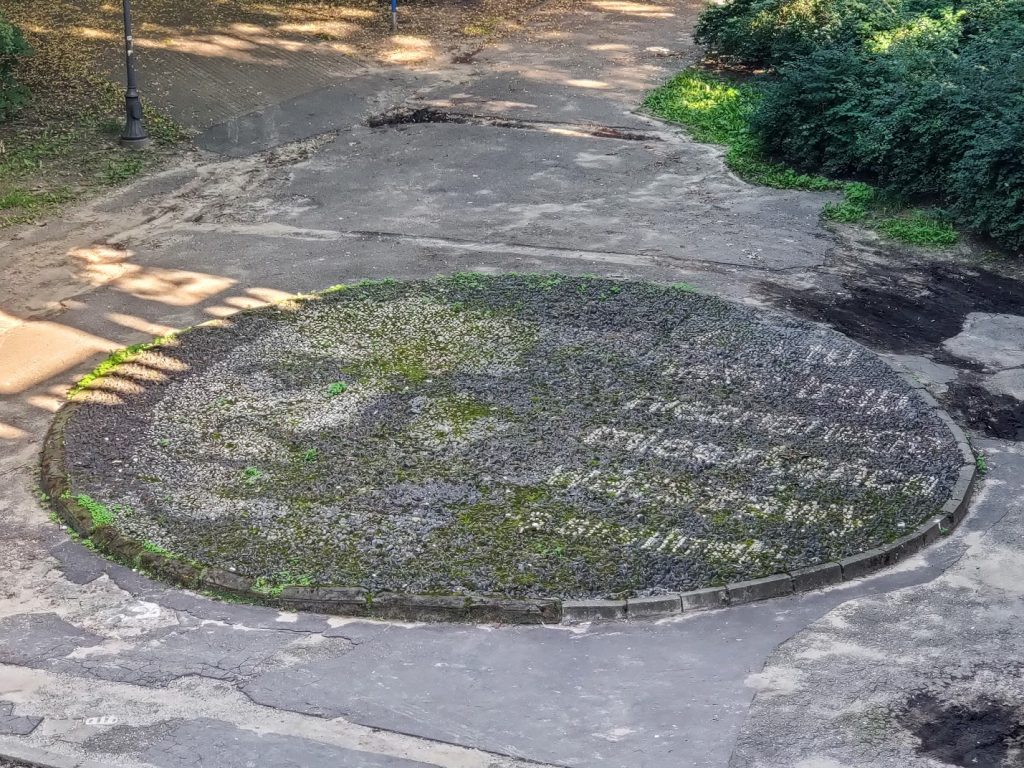
The stone mosaic by Michał Zadara titled “Here lies the corpse of the unknown inhabitant of Warsaw” commemorates the civilian victims of the Warsaw Uprising. It is an enlarged photo of a woman who probably died in the uprising. The official name of the monument, “Portrait of an unknown Varsovianette” was taken from a poem by Antoni Słonimski: “The grave of an unknown inhabitant of Warsaw”. As many as 33,000 stones measuring 3-5 cm were used to create the composition, and their collection was supervised by the Warsaw Uprising Museum.

HOW TO GET TO THE NEXT STOP
Now that you’ve seen the mosaic, turn left to go around the Poniatowski Bridge from the left. Follow the platform and the bridge river-bound and you will arrive at yet another staircase that will take you down to the former building of the Warszawa Powiśle railway station.
BACK TO THE MAP / BACK TO THE LIST
18. WARSZAWA-POWIŚLE RAILWAY STATION
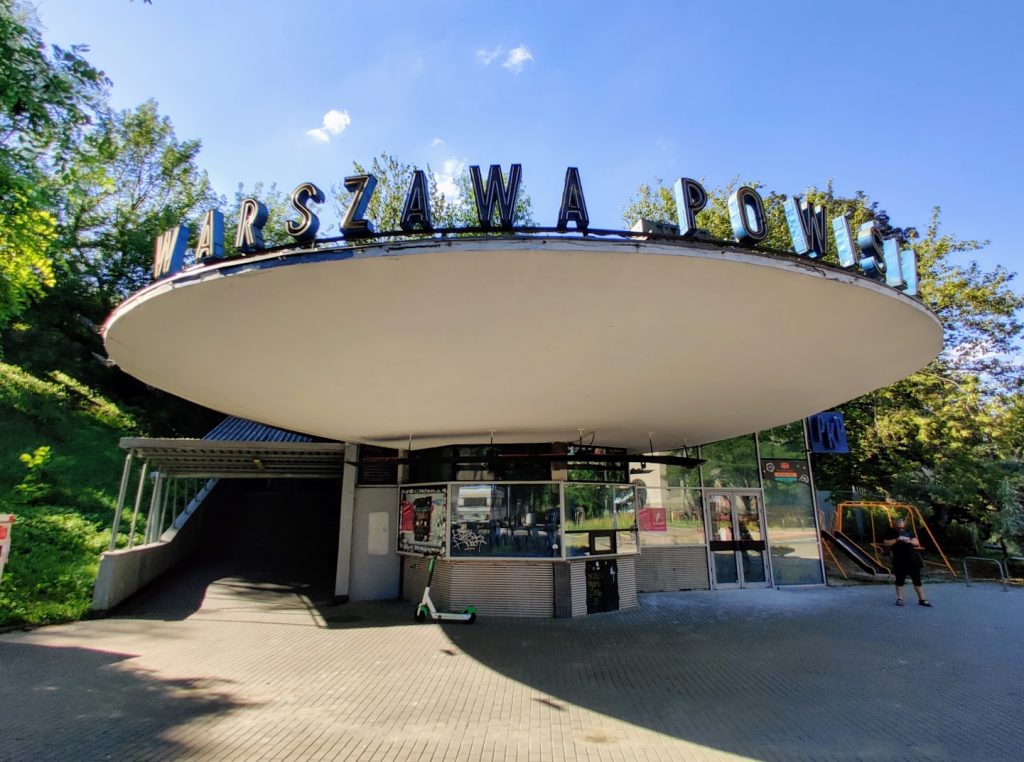
The work of Arseniusz Romanowicz and Piotr Szymaniak, the station was put into use on 29th September 1963. Owing to its location ‘at the bottom of a hill’, the stop was to be called “Skarpa” which means ‘slope’. Half a century ago, it was an example of ultra-modern architecture making good use of the possibilities of concrete shell structures. Romanowicz already in the 1930s worked on the construction of the Main Railway Station, and after the war, together with Szymaniak, he designed most of Warsaw’s stations, including the Central Railway Station. The “Warszawa-Powiśle” railway station has been entered in the register of monuments due to its historical, scientific, and artistic values. Inside the former ticket office of the station, a cosy and popular café is now located (currently undergoing renovation).
BACK TO THE MAP / BACK TO THE LIST
19. MOST PONIATOWSKIEGO (PONIATOWSKI BRIDGE)
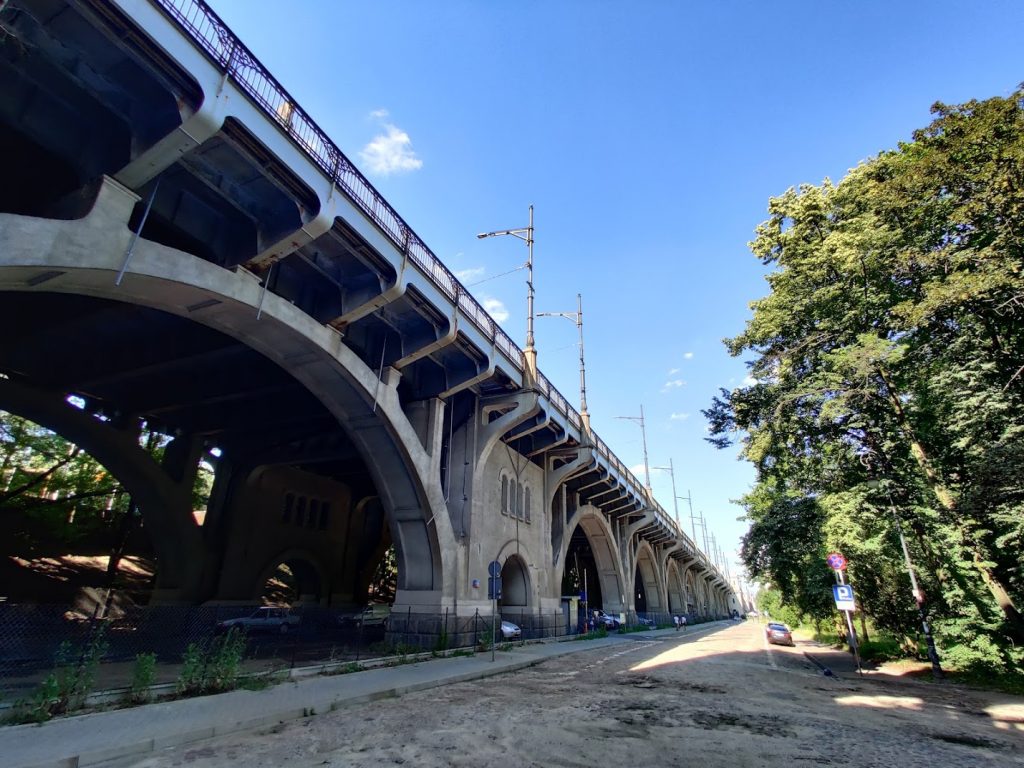
The most interesting of all the bridged in Warsaw architecture-wise was built just before the outbreak of the Great War. It was opened to public use in January 1914. The 700-metre-long viaduct leading to it was back then the largest reinforced concrete structure in the world! At the beginning, it had officially been called the Nikolaevsky Bridge (after Tsar Nicholas II, of course), but the name was changed after the Russians withdrew from Warsaw in 1918. The neo-Renaissance décor with impressive turrets is the work of Stefan Szyller, to whom we also owe such famous buildings as the University of Warsaw gate, the main building of the Warsaw University of Technology and the building where Zachęta Gallery is located.

HOW TO GET TO THE NEXT STOP
Getting to the Bohemian Turret is not the easiest of tasks. Continue further along the Poniatowski Bridge and the quaint Arkada shopping centre. After a short walk, let’s turn right and take the extended stairs to the end of the aforementioned shopping centre from the side of the Vistula river. On the left-hand side there’s a turret (facing the archway, not the river – as seen below in the photo below) and this is our final stop on this trail.
BACK TO THE MAP / BACK TO THE LIST
20. CZESKA BASZTA (BOHEMIAN TURRET)
Tower base in Solec Street, Poniatowskiego Bridge 81B/B22
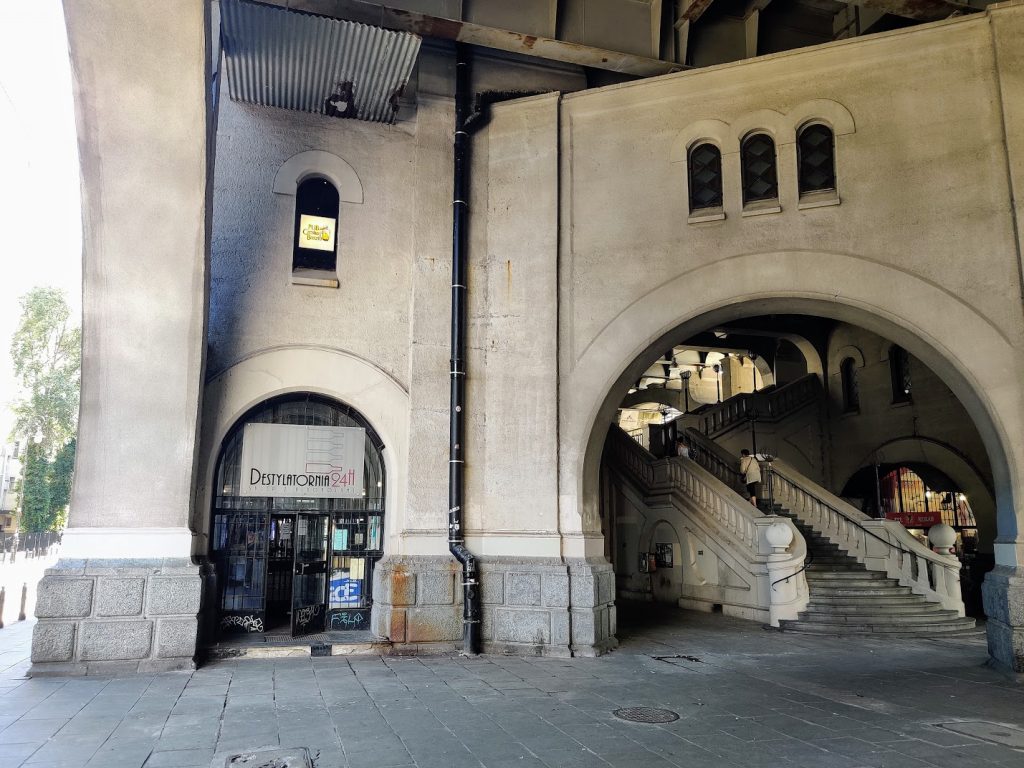
Czeska Baszta (Bohemian Turret)
The pub’s Facebook page
Number of taps: 5
Opening hours:
Monday: closed
Tuesday-Thursday: 4 pm–10 pm (oftentimes longer)
Friday-Saturday: 4 pm–11 pm (oftentimes longer)
Sunday: closed
A Warsaw pub located in one of Poniatowski Bridge’s tower bases with a huge selection of Czech beers, both from small family-owned breweries brewing classic styles and Czech craft breweries. The beer house is unique on a European scale – even the Czechs who visit this place are often amazed from how remote corners of their country beers are brought to be poured here. Nowhere else in Poland will you find such a selection of pilsners and lagers in such excellent quality (don’t worry: IPAs, APAs, stouts and porters will also be there). Five rotating taps and two huge refrigerators with bottled beer, both glass and PET (plastic) bottles. What is there to eat? Original Czech snacks, fried cheeses, among them the king of Czech cheese – nakládaný hermelín marinated in olive oil (most importantly, the owner takes great care that the cheese served to guests is ripe and well-aged). The décor makes one think of a Czech hospoda, there are wooden benches and many souvenirs related to Czech breweries on the walls. The place is small, but very cosy. The tower base keeps you cool in summer and warm in winter. The restaurant is famous for an exceptionally colourful and original group of regulars.
